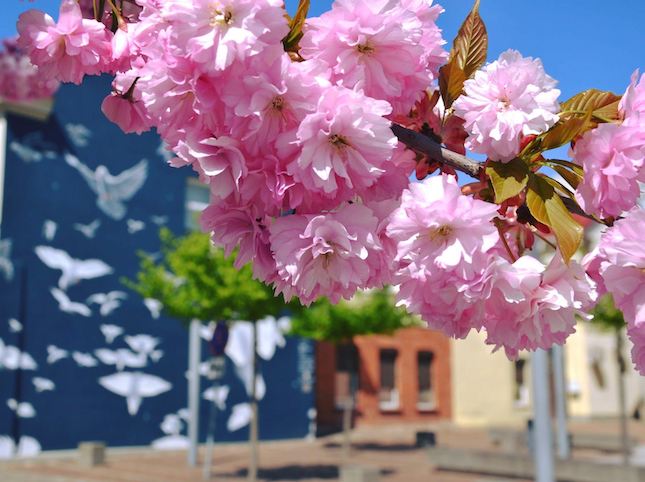As Europe slowly approaches the warmer part of the year, those looking to stumble upon yet-undiscovered places or see it all from a new perspective are invited to experience flower tourism in Lithuania. Lithuania Travel, the national tourism development agency, invites visitors to explore the flowering regions in an unforgettable blossoming trip.
April 29, 2022. Lithuania Travel, the national tourism development agency, together with the country’s tourist information centers invites visitors from all over the world to tour the country in full bloom and stumble upon yet-undiscovered places such as a primrose valley in Šeteniai, the birthplace of Nobel Prize winner Czesław Miłosz, or a daisy feast in an authentic Ilzenbergas Manor, located on the Lithuanian-Latvian border.
According to Neringa Sutkaitytė, local tourism expert at Lithuania Travel, spring is a perfect time to explore the true beauty of Lithuania. “In the coming months, the country will be in full bloom and the visitors will be able to admire the blossoming nature throughout the country,” she said.
Here are five ideas for an unforgettable spring trip to admire the vibrant plethora of flowers — matricarias, daffodils, forget-me-nots, even sakuras — in Lithuanian countryside.
1. Daffodil feast in Lithuania’s resort town
Although the first mentions of the daffodil, also known as narcissus, can be traced as far as ancient Greece, the flower found its popularity in Europe only a few centuries ago. Druskininkai, Lithuania’s resort town best known for the abundance of therapeutic and wellness SPAs, is quite fond of the flower.

Each year, Vijūnėlė Park lights up with the yellow blooming daffodils — the spring blossoms cover almost the entire area of the park, with more than half a million flowers blooming, making it a sight not to be missed.
2. Primroses straight from the pages of Nobel Prize winner’s book
When visiting Šeteniai, the birthplace of Nobel Prize winner Czesław Miłosz, it is impossible to miss the area’s wildflower frenzy. In the valley of Nevėžis, also known as Miłosz’s Meadow, primroses blossom. The flower was extensively mentioned in the poet’s autobiographical novel “The Issa Valley.”
Since primrose is considered to be a mood-lifting flower, it is suited best for those who are under a lot of stress or are often in a bad mood. The flower, which is affectionately called the “golden key,” marks the transition to summer and will be a delight in May when visiting the Kėdainiai district.
3. Experiencing sakura by sight, smell, and taste
Sakura, the Japanese cherry tree that everyone loves, has spread all over Lithuania. Among the must-see sites for the fans of the tree is Sakura park in Vilnius. The park is adored by the locals and tourists who come here to have lunch, take a selfie, or enjoy spontaneous music or art performances. The park was founded in 2001 to commemorate the 100th anniversary of Japanese diplomat Chiune Sugihara — a collection of 200 trees was a gift from Japan’s people to Lithuania to strengthen the friendly relations between the two countries.
In Marijampolė, sakura lovers gather in Cat’s Yard. Surrounded by sakuras, visitors can admire multiple murals and are invited to try to count the statues of cats owned by the town’s founder, countess Pranciška Butlerienė.
Visitors can not only smell and admire sakuras, but also taste them in the largest Japanese garden in Europe. Located in Mažučiai, Kretinga district, the garden hosts sakura tea tasting ceremonies all throughout the blossom season. The tea is made from sakura blossoms pickled in Japanese plum vinegar and sprinkled with sea salt — this kind of tea is only drunk on special occasions in Japan.
4. Lithuania’s freedom flower among 200 thousand crosses
Myosotis, also known as forget-me-not, is used throughout Lithuania to commemorate the Soviet aggression in Vilnius in the early 1990s. In May, thousands of forget-me-nots bloom on the Hill of Crosses — a world-famous, must-visit location near Šiauliai. The tradition of bringing a cross to leave on the hill began almost 200 years ago and by the early 20th century it was already known as a sacred place for masses, devotions, and pilgrimages.
Even though it is a remarkable sight at any time of the year, the hill turns blue with thousands of forget-me-nots in the spring, making the view even more phenomenal, especially during the so-called “golden hour.” The full effect of the lush rolling fields and blue flowers unfurl before visitors who come to the hill shortly after sunrise or before sunset.
5. Little daisies in an authentic manor
Daisies are the pride of Ilzenbergas Manor, located on the Lithuanian-Latvian border. The 17.5-hectare park is a great place to stroll around and immerse oneself into the life of nobility. There are a myriad of sculptures around the park, as well as an authentically restored barn, smokehouse, sauna, artillery battery, and even a 3D replica of the Stelmužė tree, one of the oldest oaks in Europe.
After a tour, visitors can grab some tasty goodies from Ilzenbergas farm — the only manor in the Baltics that continues the traditions of natural farming — and have a picnic among the daisies for an unforgettable spring experience.
Tourists eager to explore other blossoming destinations, can find more information on the Lithuania Travel website.